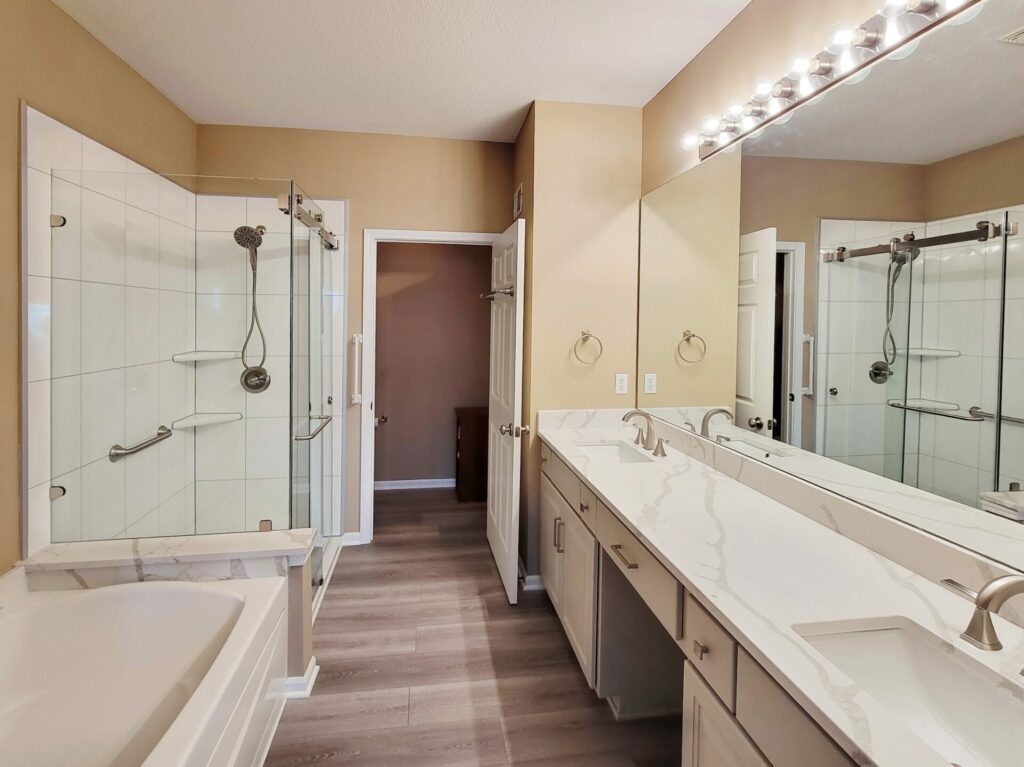At Thrive Homes, we want to provide comfort and knowledge throughout your accessibility remodel. From the very early research stages to the final product, we’re your handicap remodel specialist. So, we’ve compiled this checklist for your accessible bathroom remodel.
When remodeling a bathroom for handicap accessibility, consider the following:
- Doorway width: Ensure the doorway is wide enough for a wheelchair or walker to pass through.
- Flooring: Choose slip-resistant flooring that is easy to clean and maintain.
- Shower: Install a roll-in shower or a shower with a built-in seat and grab bars.
- Toilet: Consider installing a raised toilet or a comfort-height toilet with grab bars.
- Sink: Install a sink with knee space or a wall-mounted sink to accommodate a wheelchair.
- Lighting: Install bright and even lighting to improve visibility.
- Mirrors: Install mirrors at a lower height for individuals in wheelchairs.
- Hardware: Replace doorknobs with lever handles for easier access.
- Ventilation: Ensure the bathroom is well-ventilated to reduce moisture and prevent mold.
- Space: Plan for ample space for maneuvering a wheelchair or walker within the bathroom.
Considering these factors, you can create a safe, functional, and comfortable bathroom for individuals with disabilities.
A bathroom remodels that accommodates individuals with disabilities is often referred to as a handicap bathroom remodel, accessible bathroom remodels, bathroom remodels for the disabled or handicapped home remodeling. These remodels are designed to make the bathroom more usable and accessible for people with physical limitations, such as those who use wheelchairs, walkers, or have limited mobility.
When planning a handicapped bathroom remodel, it’s essential to consider the needs of the individual who will use the space. For example, the doorway must be wide enough for a wheelchair or walker to pass through, and the flooring should be slip-resistant and easy to clean.
A key element in an accessible bathroom is remodeling the shower.
Installing a roll-in shower or a shower with a built-in seat and grab bars makes it easier and safer for individuals with disabilities to use the shower. Toilets should also be considered, and a raised toilet or a comfort-height toilet with grab bars may be a good option.
In addition to the shower and toilet, sinks and mirrors should also be installed at a height that is accessible for individuals in wheelchairs. The hardware, such as doorknobs, should also be replaced with lever handles for easier access. Proper ventilation is also essential to reduce moisture and prevent mold.
Finally, for a handicapped bathroom remodel, ample space should be planned for maneuvering a wheelchair or walker within the bathroom. This can include wider doorways, additional space for turning, and strategically placed grab bars.
The process of bathroom remodels generally involves planning through to clean up. In planning and design, we determine your goals and needs. We work with your budget and manage sourcing products that meet your needs. We’ll propose a layout and materials.
During the demolition phase of your bathroom remodel, we’ll remove any necessary fixtures, cabinets, tiles, and other elements in the bathroom. Depending on the size of the project, this phase may require renting a dumpster on-site for the waste. During the rough-in, we’ll install any new plumbing and electrical systems. Rough-in is typically needed when a bathroom layout and structure changes significantly or if the existing elements are dated and unsafe. Structural updates will also take place during this phase.
Once the layout and materials arrive, it’s time for installation. During the installation, we’ll add new fixtures, like a tall toilet to suit people of varying needs, cabinets, sinks, tiles, grab bars, and hardware. Then it’s on to the details, or the finishing phase. This involves painting, installing accessories, and making the final touches to complete the accessible bathroom renovation. Finally, an inspection will ensure that the work meets local codes and regulations if required.
Last, of course, is the cleanup. This part of the process involves removing any debris. After a renovation, your newly handicapped-accessible bathroom may produce more dust while the materials settle. This is normal and to be expected. Clean the room regularly to eliminate hazards. The exact process may vary depending on the specific project and the homeowner’s needs. Considering these factors, bathroom remodels for disabled individuals can result in a safe, functional, and comfortable space that meets the needs of everyone who uses it.

